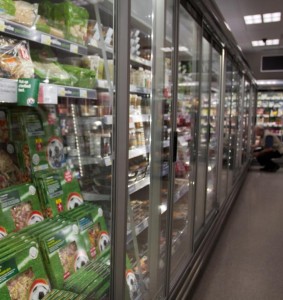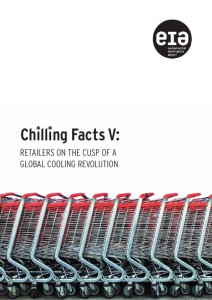Giving retailers the clarity to move towards a greener future
During my weekly shop, I try to make an effort to reduce the environmental impact of what I’m buying, from remembering to stuff a few grubby plastic bags in my handbag before I leave home to avoiding those yummy baby sweet corn with enough air miles to get them into the BA club lounge at Heathrow!

Refrigeration systems can be major users of F-gases (c) EIA
While my efforts are laudable and buying locally produced seasonal fruit and veg can only be a good thing for the environment, through working with retailers for over five years I have come to learn about an elephant in the room – the refrigeration used in supermarkets.
We all know that these systems use a lot of energy but I’m betting that you’ll be shocked to know that often the biggest climate impact actually comes from the refrigerant gases used in the systems. In fact, leaking refrigerant gases can account a whopping 20-40 per cent of a retailer’s entire carbon footprint, and that’s before the energy used by the refrigeration has even been considered!
These staggering figures are due to a group of gases called hydroflurocarbons (HFCs). HFCs are used as refrigerant gases but, ironically, while they are very good at cooling down our food they are even better at warming the Earth, with global warming potentials many thousands of times greater than carbon dioxide. For example, a leak of just 1kg of the most commonly used HFC in supermarket refrigeration has the equivalent impact of four tonnes of carbon dioxide.
 The good news is that there are alternatives available and for the past five years we at EIA have published annual reports based on information supplied by retailers and aiming to encourage them to swap out of HFCs. And the message seems to be getting through, to some. This year’s Chilling Facts report has had higher participation than ever, with more than 20 retailers from across Europe taking part and we’re pleased with the progress being made by some supermarkets. Throughout Europe, the number of hybrid cooling technology systems (which use a mixture of HFCs and alternative technology) being used in stores has risen to 589, while more than 1,000 additional stores are using HFC-free technology.
The good news is that there are alternatives available and for the past five years we at EIA have published annual reports based on information supplied by retailers and aiming to encourage them to swap out of HFCs. And the message seems to be getting through, to some. This year’s Chilling Facts report has had higher participation than ever, with more than 20 retailers from across Europe taking part and we’re pleased with the progress being made by some supermarkets. Throughout Europe, the number of hybrid cooling technology systems (which use a mixture of HFCs and alternative technology) being used in stores has risen to 589, while more than 1,000 additional stores are using HFC-free technology.
However, we’re still concerned by on-going high emissions from HFCs in the retail sector; on average, the carbon impact of emissions from leaking refrigerant gas is still higher than that associated with energy usage from the refrigeration equipment.
Some retailers accept their environmental responsibilities and are investing in HFC-free systems, but others have yet to be convinced and for this reason we have made energy efficiency a focal point of this year’s report.
During the past few years, we have seen climate-friendly refrigeration progress in leaps and bounds to the extent that today many retailers are telling us that well-designed HFC-free systems have an additional climate benefit as they also use less energy than their HFC-based counterparts. This double-win for the climate is good news for us at EIA as we know that cheaper electricity bills are certainly something that will get make retailers’ attention!
But despite the evident benefits of going HFC-free, the reality is that most retailers across Europe do not have plans to move away from HFCs. This is because the alternative technologies require a shift in mind-set – they can sometime be more challenging for technicians to work on, and upfront costs are still slightly higher even though the long-term energy savings mean running costs are reduced.
What’s needed now is a regulatory signal to level the playing field, and there is a chance this could be about to happen; over the next few months, the powers-that-be in Brussels and national governments will be fleshing out a new European regulation on HFCs, including consideration as to whether HFCs should be banned in new stationary refrigeration equipment from 2020.
EIA is keen to see such a ban as we think it will give the supermarket sector the clarity it needs in order to move forward in a more sustainable way – and, besides, two-thirds of the retailers participating in this year’s Chilling Facts survey are already on track to stop using HFCs from 2015, a full five years ahead of any possible regulation.

